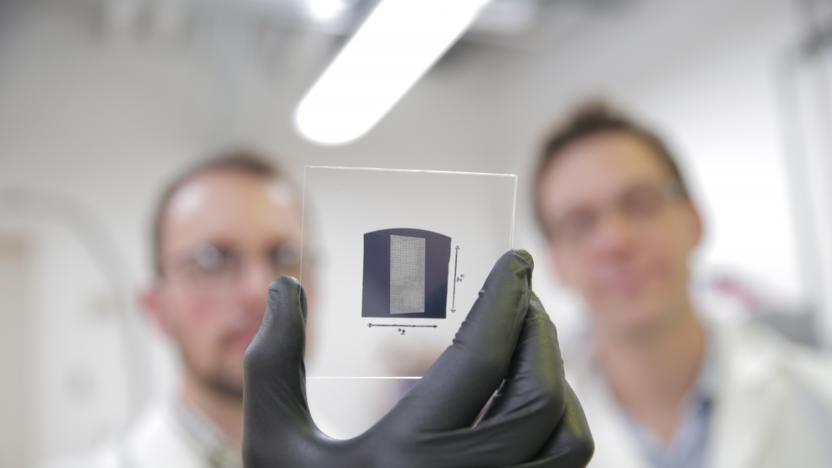UniversityOfWisconsin
Latest

Apple wins appeal in $234 million patent infringement case
Apple has won its attempt to have a patent infringement damages award against it reversed. In 2015, a jury found that Apple had infringed University of Wisconsin-Madison patents with some iPhone processors, and ordered the company to pay the Wisconsin Alumni Research Foundation (which handles the university's patent licensing) $234 million. Last year, a judge increased that figure to $506 million after determining Apple continued to infringe the patent until it expired at the end of 2016.

Carbon nanotube transistors promise faster, leaner processors
The computing industry sees carbon nanotube transistors as something of a Holy Grail. They promise not just faster performance and lower power consumption than silicon, but a way to prevent the stagnation of processor technology and the death of Moore's Law. However, their real-world speed has always lagged behind conventional technology... until now, that is. University of Wisconsin-Madison researchers have created what they say are the first carbon nanotube transistors to outpace modern silicon.

Doctors can now grow human vocal cords in a lab
Used to be that if you damaged your vocal cords and needed a new set, doctors would have to shoot you full of immunosuppressants to keep your body from rejecting the cadaver-sourced replacements. Not anymore. Researchers at University of Wisconsin Medical School have published a preliminary study in the journal Science Translational Medicine wherein they successfully cultured 170 sets of vocal cords in the lab. These organs do not require the course of immunosuppressants that conventional transplants require. "We never imagined that we would see the impressive level of function that we did," study senior author Nathan Welham told Buzzfeed.

Jury rules Apple owes $234 million for University of Wisconsin patents
Apple's loss of a patent infringement case to the University of Wisconsin could turn out to be a costly one, as a jury ruled today that it owes the Wisconsin Alumni Research Foundation $234 million. The technology at issue is used for A7, A8 and A8X processors (found inside the iPhone 5S, iPhone 6 series, iPad Air, iPad Mini 2, Apple TV 4 and other devices), and is supposed to increase efficiency. Apple told Reuters that it plans to appeal the ruling, but had no further comment. It had argued that WARF deserved a total fee of less than the $110 million Intel paid in a settlement over the patents, but the jury decided differently. While it can certainly handle the financial hit ,the trouble may not stop there -- WARF has also filed a lawsuit against Apple for its new A9 CPUs that are inside the new iPhone 6s family and iPad Pro. Update: WARF managing director Carl Gulbrandsen said "The jury recognized the seminal computer processing work that took place on our campus. This decision is great news for the inventors, the University of Wisconsin-Madison and for WARF." [Image credit: Bloomberg via Getty Images[

Apple found liable for using University of Wisconsin's patent
Apple can't win every patent lawsuit it's involved with. Here's a good case in point: the tech giant has been found liable of using technology patented by the University of Wisconsin in 1998 without the proper permission. To be precise, that technology was designed to improve chip efficiency as you can see in this USPTO filing, and it was used in iPhones and iPads. The Wisconsin Alumni Research Foundation (WARF) filed a case against Intel back in 2008 for using the same patent, but it was immediately settled out of court. It launched the lawsuit against Cupertino in January last year.

UW-Madison researchers invent a metal-free fuel cell
The development of fuel cell technology has been hamstrung by the need for expensive and difficult-to-manufacture catalysts like platinum, rhodium or palladium. But a team of researchers from the University of Wisconsin-Madison believe they've found an ingenious alternative that employs a molecular, rather than solid, catalyst.

3D-printed music scores help the blind feel every note
It's increasingly apparent that schools can do exceptional things when you give them 3D printers. Need proof? The University of Wisconsin's Mechanical Engineering department is using its advanced selective laser sintering printer to make a wide range of intricate projects, including 3D music scores for the blind. The creation replaces Braille (which sometimes omits crucial details in music) with extruded versions of the same notes you see on regular sheets -- you can interpret those arpeggios in the same way as any other performer, rather than learn a separate system. The university is still refining the concept, so it may take a while before blind virtuosos are using 3D sheets in concerts. You'd need an easy way to mass-produce them, for one thing. If the technology pans out, though, it could open doors for vision-impaired artists. [Image credit: Scott Gordon]

Atom-scale brain sensors will show exactly how your mind works
Neural activity maps frequently present an incomplete picture of how a brain works; you can measure electrical activity, stimulate it or visualize the anatomy, but you can't do all three. DARPA and the University of Wisconsin might just pull off that seemingly impossible feat, however. They recently built a hybrid brain sensor that combines both electrical and optical techniques to present a vivid picture of what's happening inside the mind. The sensor is primarily made of ultra-thin graphene (just four atoms thick) that both conducts electricity and lets light through. By putting this device on top of neural tissue, you can simultaneously create brain activity and monitor virtually every aspect of it. Graphene is safe for your body, too, so you shouldn't face the same risks you see with metal alloys.

Everything Mark Zuckerberg has said in public is available online, but only for your PhD
If you're worried that Facebook knows too much about you, you'll be glad to know that a University of Wisconsin team is returning the favor; it just launched The Zuckerberg Files, an attempt to collect everything that Mark Zuckerberg has said in public. The archive currently offers nearly 50 videos as well as 100-plus articles that include interviews, official messages and transcripts. Don't expect easy access, however. At present, the files are limited to academics -- unless you're writing a thesis on the intricacies of Silicon Valley politics, you'll have to find Zuck quotes the hard way.

Mind-reading robotic teachers are more... Anyone? Anyone? Attention-grabbing
You'd have thought that replacing a human teacher with a swanky robot would be enough to keep the kids interested, but apparently not. The University of Wisconsin-Madison found that supplying a robot teacher didn't in itself max out concentration. In one trial, they put a Wakamaru robot instructor in the classroom with only mediocre results. But then they switched it out for a robot that could read students' EEG signals to tell when they were enjoying Matthew Broderick daydreams, and which could then change its intonation or wave its metallic hands in response. That second robot resulted in far better scores when the students were subsequently quizzed about their lessons, proving once again that teaching is about more than preaching.

Twitter-brain interface offers terrifying vision of the future
We'll be honest, we're always on the lookout for faster and better ways to annoy our Twitter followers with hopelessly mundane status updates, and this brain-control interface from the University of Wisconsin's Adam Wilson seems to be the perfect to get all Scoble on it with a minimum of effort -- you think it, you tweet it. Okay okay, we kid -- it's actually just the usual brainwave-control setup you've seen everywhere, and the average user can only do ten characters a minute, but think of the potential, people. Soon everyone will know that you are "Walking on sidewalk, LOL" almost the second you think it, and all it will take is a mindreading cap paired with a sophisticated computers running an advanced signal processing algorithm connected to the massive infrastructure of the internet via a multibillion-dollar mobile broadband network. That's progress. Video after the break.[Via Hack A Day]

Researcher plans to use GPS to study asthma triggers
You wouldn't expect GPS tech to have an impact on asthma research, but the University of Wisconsin-Madison's David Van Sickle says it will -- he's planning on tagging sufferers so he can learn when and where they reach for their inhalers. The data will hopefully make sorting out environmental triggers of the disease much easier -- it took scientists eight years to prove that soybean dust near the Barcelona harbor caused a massive asthma outbreak in the 80s, a timeline that might have been dramatically shorter if location information had been available from the start. The plan's still in the early stages, but would-be participants can sign up already -- let's just hope the tracker is slightly more attractive than Kogan's enormous watch unit.[Via CNET]





